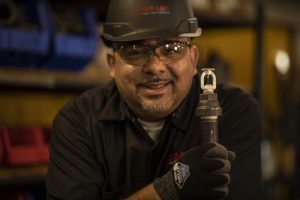Fire sprinkler systems continue to be one of the most effective ways to save lives and protect property. Having the right fire sprinkler system in place in your facility is very important for improving life safety. There are various options for fire sprinkler systems, and the one that is right for you will depend on your application and the hazards that are present.
Wet Fire Sprinkler Systems
When you think of a fire sprinkler system, you probably think of a traditional wet system. It is the most common sprinkler system due to its effectiveness and versatility. In a wet pipe fire sprinkler system, water is contained within the sprinkler pipes. When a fire occurs and the system is activated, only the sprinkler head nearest to the fire will discharge water onto the flames. Wet pipe systems are easy to install and maintain and are cost-effective due to their simplicity. Applications for wet fire sprinkler systems may include office buildings, apartments, assisted living facilities, hotels, schools and much more.
Dry Fire Sprinkler Systems
The main way dry fire sprinkler systems vary from wet fire sprinkler systems is that water is not contained within the sprinkler pipes under normal conditions. In a dry pipe system, the pipes are filled with pressurized air instead of water. Only when the system is activated will water be released into the sprinkler pipes. Dry fire sprinkler systems are installed in areas with low temperatures where pipes run the risk of freezing. Although dry sprinkler systems are more expensive to install and maintain and have a slightly longer response time in a fire, they are necessary in some applications. Frozen and burst pipes could cause a lot of damage to a building and cause the fire sprinkler system to fail. Some common applications where dry fire sprinkler systems are found include unheated warehouses, freezers, outdoor parking garages, and any area that is exposed to freezing temperatures.
Pre-Action Sprinkler Systems
Pre-action systems combine elements of both wet and dry sprinkler systems. In a pre-action system, the sprinkler pipes are filled with air like a dry system. The difference is that pre-action systems require a two-step process to activate. First a heat or smoke detector will detect a fire which will cause the sprinkler pipes to fill with water, creating a wet system. Then, the sprinkler head closest to the fire will activate to discharge water onto the fire. There are two types of pre-action systems: single interlock and double interlock. The complexity of pre-action systems makes them a little more difficult to install and maintain than traditional sprinkler systems. A pre-action system is typically installed in applications where accidental activation could cause serious damage to assets such as museums, libraries, freezer warehouses, data centers, and archives.
Deluge Fire Sprinkler Systems
A deluge fire sprinkler system has unpressurized, dry pipes with open sprinkler heads. This system is connected to a water supply and water is held back by a valve. When the valve is opened after a fire is detected, water floods the system and is discharged through all the open sprinkler heads. A deluge system works well in high hazard applications because water is released through all the sprinkler heads simultaneously, dousing the area to put out a fire more quickly. Some common applications for deluge systems include aircraft hangars, power plants, and chemical plants.
Install a Sprinkler System with Beach Lake Sprinkler
 At Beach Lake Sprinkler we design, install, inspect, and service fire sprinkler systems. If you need a fire sprinkler system installed in your application, we will help you determine which system is right for you and provide design in accordance with NFPA and local standards. Our team can also provide service for existing fire sprinkler systems including wet, dry, pre-action, and deluge systems. We can set up an inspection and service plan for your fire sprinkler system to fit your needs and keep you code compliant. To learn more about our services, contact us today.
At Beach Lake Sprinkler we design, install, inspect, and service fire sprinkler systems. If you need a fire sprinkler system installed in your application, we will help you determine which system is right for you and provide design in accordance with NFPA and local standards. Our team can also provide service for existing fire sprinkler systems including wet, dry, pre-action, and deluge systems. We can set up an inspection and service plan for your fire sprinkler system to fit your needs and keep you code compliant. To learn more about our services, contact us today.